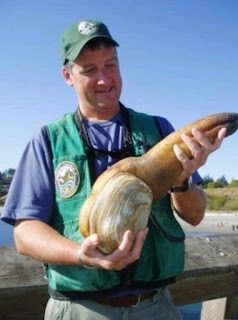GEODUCK

T he Pacific geoduck ( Panopea generosa) is a species of very large saltwater clam in the family Hiatellidae. The geoduck is native to the coastal waters of the eastern North Pacific Ocean from Alaska to Baja California. The shell of the clam ranges from 15 centimetres (6 in) to over 20 centimetres (8 in) in length, but the extremely long siphons make the clam itself much longer than this: the "neck" or siphons alone can be 1 metre (3 ft 3 in) in length. The geoduck is the largest burrowing clam in the world. It is also one of the longest-living animals of any type, with a typical lifespan of 140 years; the oldest has been recorded at 179 years old. The precise longevity of geoducks can be determined from annual rings deposited in the shell which can be assigned to calendar years of formation through crossdating. Taste So, what does it taste like? Geoduck meat is sweet and clear in taste. Eggs Geoducks are extremely productive, with the long-lived female...
